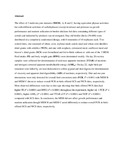| dc.identifier.citation | M. Waititu, Samuel, Anna Rogiewicz, Bogdan A. Slominski, Joyce G. Maina, James O. Ochanda, and Charles M. Nyachoti. "Effect of Multi-Enzyme Mixtures on Performance and Nutrient Utilization in Broilers Fed Diets Containing Different Types of Cereals and Industrial By-Products." The Journal of Poultry Science (2014). | en_US |
| dc.description.abstract | The effect of 3 multi-enzyme mixtures (MEM), A, B and C, having equivalent phytase activities but with different activities of carbohydrases (except invertase) and protease on growth performance and nutrient utilization in broiler chickens fed diets containing different types of cereals and industrial by-products was investigated. Day-old broiler chicks (N=400) were distributed in a completely randomized design, with 8 treatments of 10 replicates each. Two control diets, one consisted of wheat, corn, soybean meal, canola meal and wheat-corn distillers dried grains with solubles (WCS), and one with sorghum, cottonseed meal, sunflower meal and brewer’s dried grains (SCS) were formulated and fed to birds without or with one of the 3 MEM. Feed intake (FI) and body weight gain (BWG) were determined weekly. On day 20 excreta samples were collected for determination of total tract apparent retention (TTAR) of nutrients and nitrogen corrected apparent metabolizable energy (AMEn). On day 22, eight birds per treatment were killed by cervical dislocation to collect jejunal and ileal digesta for determination of viscosity and apparent ileal digestibility (AID) of nutrients, respectively. Diet and enzyme interactions were only detected for overall feed conversion ratio (FCR, P < 0.001) with MEM B and MEM C shown to reduce overall FCR in birds offered SCS and WCS diets, respectively. Most observed differences were due to diet type showing that birds offered WCS diets had higher FI (P < 0.0001) and BWG (P < 0.0001) throughout the experiment, higher wk 1 FCR (P < 0.0001), higher AMEn (P < 0.0001) and TTAR of P (P < 0.0001) and NDF (P < 0.0001) compared with SCS diets. In conclusion, the MEM did not affect growth performance and nutrient utilization though MEM B and MEM C acted differently to reduce overall FCR in birds offered SCS and WCS diets, respectively. | en_US |

